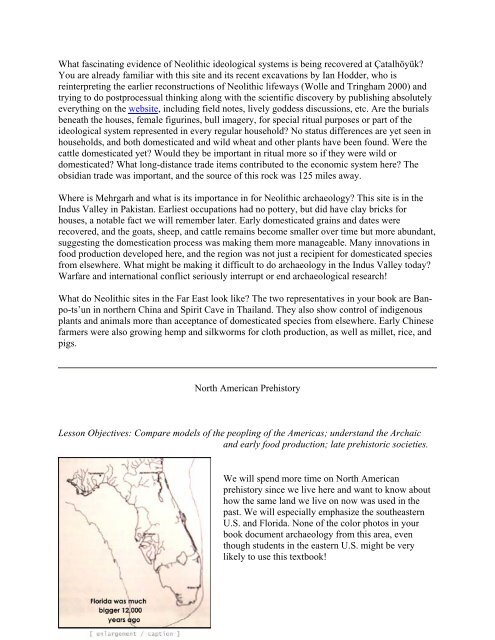INTRODUCTION TO ARCHAEOLOGY Nancy White - Touro Institute
INTRODUCTION TO ARCHAEOLOGY Nancy White - Touro Institute
INTRODUCTION TO ARCHAEOLOGY Nancy White - Touro Institute
Create successful ePaper yourself
Turn your PDF publications into a flip-book with our unique Google optimized e-Paper software.
What fascinating evidence of Neolithic ideological systems is being recovered at Çatalhöyük?<br />
You are already familiar with this site and its recent excavations by Ian Hodder, who is<br />
reinterpreting the earlier reconstructions of Neolithic lifeways (Wolle and Tringham 2000) and<br />
trying to do postprocessual thinking along with the scientific discovery by publishing absolutely<br />
everything on the website, including field notes, lively goddess discussions, etc. Are the burials<br />
beneath the houses, female figurines, bull imagery, for special ritual purposes or part of the<br />
ideological system represented in every regular household? No status differences are yet seen in<br />
households, and both domesticated and wild wheat and other plants have been found. Were the<br />
cattle domesticated yet? Would they be important in ritual more so if they were wild or<br />
domesticated? What long-distance trade items contributed to the economic system here? The<br />
obsidian trade was important, and the source of this rock was 125 miles away.<br />
Where is Mehrgarh and what is its importance in for Neolithic archaeology? This site is in the<br />
Indus Valley in Pakistan. Earliest occupations had no pottery, but did have clay bricks for<br />
houses, a notable fact we will remember later. Early domesticated grains and dates were<br />
recovered, and the goats, sheep, and cattle remains become smaller over time but more abundant,<br />
suggesting the domestication process was making them more manageable. Many innovations in<br />
food production developed here, and the region was not just a recipient for domesticated species<br />
from elsewhere. What might be making it difficult to do archaeology in the Indus Valley today?<br />
Warfare and international conflict seriously interrupt or end archaeological research!<br />
What do Neolithic sites in the Far East look like? The two representatives in your book are Banpo-ts’un<br />
in northern China and Spirit Cave in Thailand. They also show control of indigenous<br />
plants and animals more than acceptance of domesticated species from elsewhere. Early Chinese<br />
farmers were also growing hemp and silkworms for cloth production, as well as millet, rice, and<br />
pigs.<br />
North American Prehistory<br />
Lesson Objectives: Compare models of the peopling of the Americas; understand the Archaic<br />
and early food production; late prehistoric societies.<br />
We will spend more time on North American<br />
prehistory since we live here and want to know about<br />
how the same land we live on now was used in the<br />
past. We will especially emphasize the southeastern<br />
U.S. and Florida. None of the color photos in your<br />
book document archaeology from this area, even<br />
though students in the eastern U.S. might be very<br />
likely to use this textbook!
















